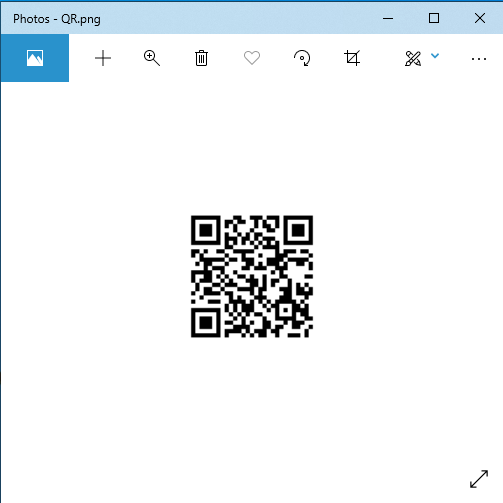ByteScout PRA Tools is a powerful app builder that you can use to develop your apps (aka “robots”). Such robots can perform business automation tasks without human interaction required.
From this article, you can learn how to create a simple QR barcode generating business automation application in less than 10 minutes. It is that simple with a pre-built template that comes with ByteScout RPA Tools.
Make Your Robots – Try RPA Tools
The purpose of this robot is to show you how you can create a QR code using RPA Tools.
To create this robot, you need to open the RPA Tools application on your computer and press the “Add Robot” button.
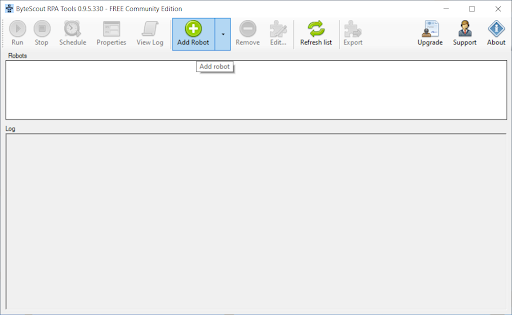
Then you can press the “2 Easy start: Create QR code” button in the “Select Template” dialog window.
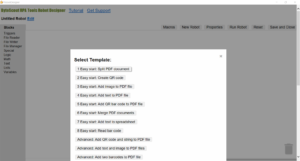
You can see the “Robot Info” informational dialog window. Please press the “OK” button.
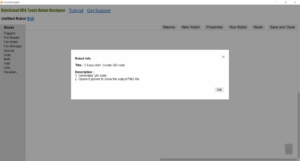
Now you have the robot created and displayed in the Designer.
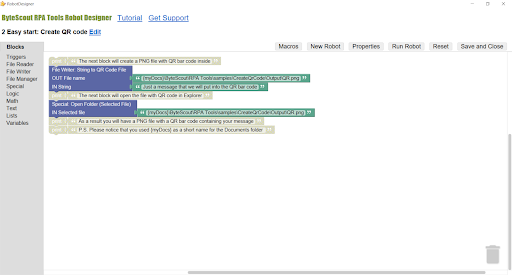
Let me explain how this robot works.
It is quite usual for our “Easy Start” robots to have just one core block, several commenting blocks, and service blocks. This robot follows suit.
Let us start from the commenting blocks as they are first from the top. These “print and “text” blocks are disabled, and this is why they are grey. The blocks advertise the next block, but they are not doing anything else.
![]()
The next block has the name “File Writer: String to QR Code File”. It is blue, and it is a core block. Indeed, we wanted to generate a QR code, and the block makes whole this robot’s job done.

You can notice that this block has parameters “IN String” and “OUT File name”. “IN” at the beginning of the parameter name stands for INPUT, and “OUT” stands for OUTPUT.
Each of these two parameters has a jigsaw connector, like the ones that puzzles have. Let us take a look at the green “text” blocks attached to each of the parameters.

The first “text” block provides a name for the output file.
We are suggesting a little trick that saves a bit of your time when you need to pass a file or a folder name as a parameter. Instead of typing a long path like C:\Users\UserName\Documents, you can use the {myDocs} macro.
(You can find all macros descriptions in a dialog window if you press the “Macros” button in the ByteScout RPA Tools Robot Designer.)
There is another green text block that contains a string “Just a message that we will put into the QR bar code”. This block is setting the content of the output QR code.
To sum up, the “File Writer: String to QR Code File” block is the core block of this robot. When it runs, it creates an output file containing a QR code with a specified text inside.
The rest of the blocks that we added to the “2 Easy start: Create QR code” robot are service blocks. They show you the results produced by the core block.

To show the results, we used a blue “Special: Open Folder (Selected File)” block. It opens Windows Explorer so you can see the “Output” folder with a created file in it.
Now, as you have this robot created and displayed in the Designer, you can save it and close the Designer window using the “Save and Close” button.
After saving, you can see the robot name in the “Robots” list of the RPA Tools application.
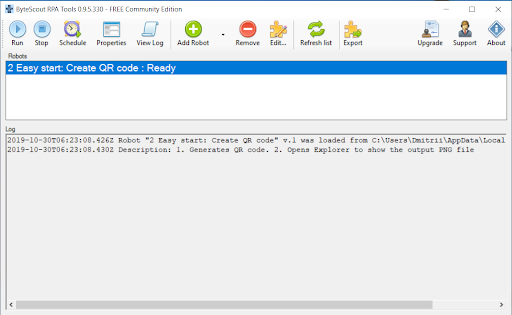
To run the robot, please press the “Run” button.
As a result of running this robot, we have a PNG file that contains a QR code.
